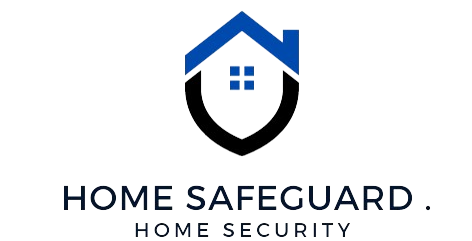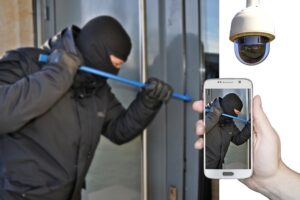Hey there! Ever wondered how to make your home as secure as Fort Knox without the complicated jargon?
Well, you’re in the right place! I’m here to spill the beans on crafting a super-effective home security plan
We’re not just talking about locks and alarms; we’re diving into the world of smart gadgets that’ll make your home the safest spot on the block.
So, whether you’re a tech whiz or just starting to dip your toes into the security pond, this guide is for you.
Essential Elements of a Home Security System
1. Smart Home Integration
Smart home integration is all about linking up your smart gadgets at home to create a seamless, automated system. This nifty setup lets you control multiple devices using just one app or interface, making your life a whole lot simpler.
Benefits of a smart home integration
- User-Friendly Operation: Imagine managing all your smart gadgets through one platform like Amazon Alexa, Google Assistant, Apple Siri, or Samsung SmartThings. It’s like having a universal remote control for your home!
- Automation Magic: With smart home integration, you can set things on autopilot. Picture this: your lights automatically switch off when no one’s around, or your thermostat adjusts itself based on your daily routine.
- Beefed-Up Security: A well-integrated smart home isn’t just about convenience; it’s also a superhero guardian. It can spot potential threats and give you a heads-up, adding an extra layer of security.
Factors to consider when choosing the right smart home integration
- Pick Compatible Devices: Make sure your smart devices play nice with each other. Check if they support the same communication language, like Wi-Fi, Bluetooth, or Zigbee.
- Central Hub Setup: Think of a smart home hub (like Amazon Echo Plus or Nest Hub Max) as the conductor of your smart device orchestra. It connects to and controls all your gadgets effortlessly.
- Create Routines and Scenes: Customize your smart home experience by setting up routines and scenes. These are like personalized scripts that make your devices dance to your tune.
2. Access Control Strategies
Access control strategies aim to limit access to sensitive areas or resources within your home, ensuring only authorized individuals have entry.
One effective method for implementing access control is through keyless entry systems.
Benefits of keyless entry system over traditional keys
- Convenience: No need to carry physical keys; simply enter a code or press a button to unlock doors.
- Security: Keyless entry systems reduce the risk of lost or stolen keys, which could lead to unauthorized access.
- Customization: You can set unique codes for family members or guests, allowing you to easily grant or revoke access privileges.
Factors to consider when choosing a keyless entry system
- Type of lock: Decide between electronic keypad locks, biometric locks (fingerprint recognition), or RFID (radio frequency identification) locks. Each type has its own advantages and disadvantages.
- Installation requirements: Determine if the system requires professional installation or if it’s user-friendly enough for DIY setup.
- Battery backup: Check if the system includes battery backup in case of power outages.
- Connectivity options: Consider whether the system supports remote access via smartphone apps or voice assistants.
3. Surveillance Systems for Vigilant Protection
Surveillance systems play a crucial role in monitoring your property and deterring potential threats.
Two essential components of surveillance systems are CCTV cameras and motion detection technology. Here’s how they contribute to your home security.
a. CCTV Cameras
CCTV stands for Closed Circuit Television, which means the footage is not publicly broadcast but rather transmitted privately to a limited number of people.
Benefits of Installing CCTV cameras
- Visual deterrence: The presence of cameras acts as a visual deterrent, discouraging would-be thieves and trespassers.
- Evidence collection: If an incident occurs, recorded footage can serve as valuable evidence for law enforcement or insurance purposes.
- Remote monitoring: Many modern CCTV systems allow you to monitor live feeds remotely via smartphones or computers.
Factors to consider when selecting CCTV cameras
- Resolution: Opt for high-resolution cameras to capture clear images and improve identification capabilities.
- Field of View: Wider fields of view cover larger areas but may compromise image quality.
- Night Vision Capabilities: Infrared LEDs enable cameras to function in low-light environments.
- Weather Resistance: Outdoor cameras must be rated IP66 or higher for protection against harsh elements.
- Power Requirements: Choose between wireless and wired cameras based on your preference and existing infrastructure.
- Recording Options: Built-in storage or compatibility with external storage solutions is important for long-term record-keeping.
- App Support: Ensure the camera works with popular smartphone apps for ease of remote viewing and management.
- Budget: Establish a budget and factor in ongoing costs, such as subscription fees or battery replacements.
b. Motion Detection Technology
This feature helps minimize false alarms caused by pets or wildlife while maximizing real threat detection.
Motion detection technology uses sensors to identify movement within a camera’s field of view and trigger an alarm or recording event.
Features to look for when evaluating motion detection technology
- Sensitivity Levels: Look for motion detection systems that offer adjustable sensitivity settings to accommodate varying degrees of motion and reduce false alarms.
- Virtual Boundaries: Ability to create customized virtual boundaries and define specific areas where motion detection is required, allowing for tailored coverage across multiple rooms or zones.
- Pet Immunity: Some motion detection systems come with pet immunity features that distinguish between human and animal movements, minimizing unnecessary alerts.
- Integration with Other Smart Home Devices: Check if the motion detection technology can be easily integrated with other smart home devices, such as doorbells, thermostats, and lighting systems, for a more streamlined experience.
- Mobile App Control: Ensure the motion detection system has a user-friendly mobile app that allows you to manage settings, view alerts, and control connected devices from anywhere.
- Real-Time Notifications: Verify that the system sends immediate push notifications to your phone or email when motion is detected, alerting you to potential intrusions or other events.
- Backup Storage: Consider whether the motion detection system includes backup storage options, such as cloud storage or local storage, to securely store captured videos and images.
Benefits of motion detection technology
- Enhanced Accuracy: By focusing on detecting actual movements instead of relying solely on sensor activation, motion detection reduces the likelihood of triggering false alarms due to environmental changes or pet activity.
- Increased Safety: With motion detection, you can receive instant alerts when someone enters a restricted area,helping to prevent accidents or unauthorized access.
- Energy Conservation: Motion detection allows lights to turn off automatically when no one is present, conserving energy and extending bulb life.
- Cost Savings: Motion detection eliminates the need for manual inspections, saving time and labor costs associated with checking each location individually.
- Seamless Integration: Motion detection technology can be easily integrated with various smart home devices, such as doorbells, thermostats, and lighting systems, creating a more efficient and convenient living environment
4. Fire Safety Protocols
Fire safety protocols are essential for protecting your property and loved ones from the devastating effects of fire.
Two crucial components of any fire safety plan are smoke detectors and fire alarms.
These devices serve as your first line of defense by providing early warning signals and initiating evacuation procedures when needed.
Here’s what you should know about them:
a. Smoke Detectors
Smoke detectors play a vital role in identifying fires before they become uncontrollable. They continuously monitor air quality for signs of combustion products, such as carbon monoxide and particulate matter.
Once a certain threshold is reached, the detector triggers an alarm, giving occupants ample time to escape.
Key aspects of smoke detectors include:
- Types: There are two primary types of smoke detectors: ionization and photoelectric.
- Ionization detectors use radioactive material to generate an electrical current that senses smoke particles.
- Photoelectric detectors rely on a beam of light that gets disrupted when smoke enters the chamber.
- Placement: Install smoke detectors at least every 10 feet along hallways and stairwells and within bedrooms. Place them at least 4 inches away from walls and ceilings, and avoid placing them near windows, doors, vents, or ducts.
- Maintenance: Test smoke detectors monthly by pressing the test button, replace batteries annually, and clean dusty filters regularly
b. Fire Alarms
A fire alarm system consists of various components working together to detect and respond to fires.
It typically includes smoke detectors, heat sensors, pull stations, horns, strobes, and annunciators.
When a fire occurs, the system activates audible and visual alarms, prompting occupants to evacuate immediately.
Important features of fire alarms include the following:
- Interconnected System: A properly installed fire alarm system interconnects all smoke detectors and alarms throughout the building, ensuring that everyone hears the alarm regardless of their location.
- Regular Inspection: Schedule regular inspections and testing of your fire alarm system to maintain optimal performance and compliance with local codes.
- Evacuation Plan: Develop and practice an evacuation plan that outlines emergency exits, assembly points, and communication methods during a fire event
5. Emergency Response Planning
An effective emergency response plan is crucial for safeguarding your family, employees, and assets during unexpected situations.
Two critical elements of this plan are panic buttons and 24/7 monitoring services.
Let’s explore how these tools contribute to a comprehensive emergency response strategy.
a. Panic Buttons
Panic buttons are easy-to-use devices designed to quickly summon assistance in case of emergencies.
They can be activated manually or through automated systems like motion detectors or glass break sensors.
Key features of panic buttons include:
- Quick Access: Panic buttons are strategically placed in accessible locations, such as kitchen counters, nightstands, or entryway tables, making them readily available during emergencies.
- Dual Functionality: Many panic buttons double as medical alert devices, allowing users to request emergency medical attention if necessary.
- Integration with Security Systems: Panic buttons can be integrated with existing security systems, sending real-time alerts to authorities and designated contacts when triggered.
b. 24/7 Monitoring Services
Professional monitoring services provide constant surveillance of your property, ensuring timely intervention during emergencies.
Trained operators closely watch over your premises using advanced software and hardware, ready to dispatch appropriate responses when needed.
Key aspects of 24/7 monitoring services include:
- Real-Time Alerting: Monitoring centers receive real-time updates on any suspicious activities or emergencies occurring at your property, enabling rapid response times.
- Customizable Plans: Choose from various monitoring plans that cater to your unique needs, budget, and preferences.
- Certified Operators: Professional monitoring companies employ certified operators who undergo rigorous training and adhere to industry standards, guaranteeing high-quality service.
6. Securing Entry Points
Securing entry points is crucial for maintaining a safe environment at your property.
By reinforcing doors and windows with security solutions, you can significantly reduce the risk of unauthorized access or break-ins.
Here are some key aspects to consider when securing entry points:
a. Reinforced Doors
Reinforced doors offer enhanced protection against forced entry attempts. Some features to look for include:
- Solid Core: A solid core door provides better resistance to impact than hollow doors.
- Locking Mechanisms: High-security locks, such as deadbolts and mortise locks, provide additional protection.
- Strike Plates: Strike plates help secure the lock by preventing the doorknob from being removed.
- Door Frames: Solid wood frames are more resistant to intrusion than hollow metal ones.
When choosing a reinforced door, consider the specific needs of your property, including the level of security required and any aesthetic preferences.
For example, if you’re looking for an attractive yet sturdy option, consider a steel door with a wooden veneer.
b. Window Security Solutions
Windows are another potential entry point that should be secured.
Consider the following options:
- Window Locks: Install high-quality window locks to prevent unwanted entry.
- Bars or Grilles: Add bars or grilles to deter burglars and protect against glass shattering.
- Security Film: Apply security film to windows to hold broken glass together, making it harder for thieves to enter through them.
- Shatterproof Glass: Replace regular glass with tempered or laminated glass, which is less likely to shatter upon impact.
7. Lighting Solutions
Proper lighting is essential for ensuring safety and security around your property.
There are several types of lighting solutions available, each offering different benefits. Two popular options are motion-activated lights and smart lighting controls. Let’s explore these two choices:
a. Motion-Activated Lights
Motion-activated lights automatically turn on when they detect movement within their range. This feature helps deter criminals and improves visibility during nighttime hours. Key advantages of motion-activated lights include:
- Energy Efficiency: They only consume electricity when needed, saving energy compared to traditional lighting systems.
- Convenience:There is no need to manually switch lights on or off; they activate based on motion detection.
- Deterrence: The sudden activation of lights can startle potential intruders, discouraging them from attempting a break-in.
b. Smart Lighting Controls
Smart lighting controls allow you to remotely manage your home’s lighting system using a mobile app or voice commands.
These systems often integrate with other smart devices, providing added convenience and customization options.
Benefits of smart lighting controls include:
- Customizable Schedules: Set schedules for lights to turn on or off at specific times, even when you’re away from home.
- Remote Access: Adjust lighting settings from anywhere, using your smartphone or tablet.
- Integration with Other Devices: Many smart lighting control systems work seamlessly with other smart home products, such as thermostats and security cameras.
Conclusion
In conclusion, a complete home security system should consist of smart home integration, access control strategies, surveillance systems, and fire safety protocols.
By incorporating these elements, homeowners can enhance their overall security while enjoying the added conveniences of connected devices and advanced features. Remember to choose compatible devices, select appropriate access control methods, invest in reliable surveillance equipment, and prioritize fire safety measures to ensure your home remains protected from potential threats.




